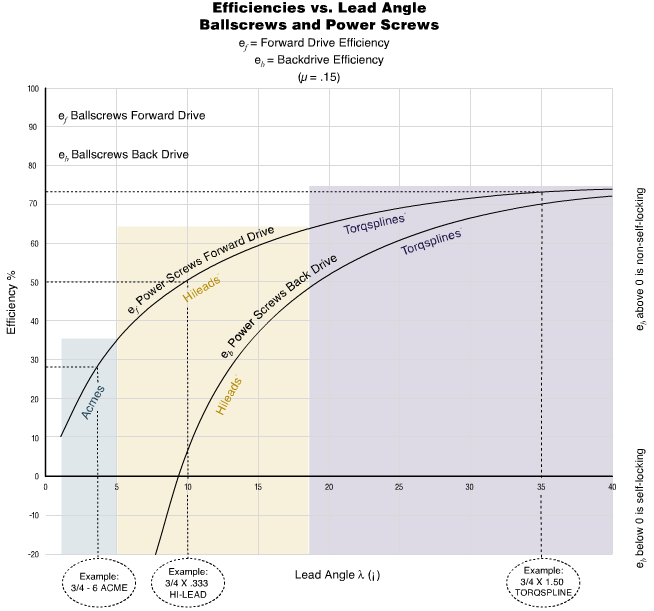Efficiency and Backdriving
The mechanical efficiency of screw drive systems is often confusing. This is because unlike most power transmission components, V-belts, sheaves, timing belts, chain drives, and gear systems (with the notable exception of worm gear systems), screw drive systems actually exhibit two efficiencies – one in the drive direction (torque to thrust conversion) and one in the backdrive direction (thrust to torque conversion).
Drive Direction (Torque to Thrust Conversion) & Backdrive Direction (Thrust to Torque Conversion)
The Efficiencies vs. Lead Angle graph (Figure 26) shows the two efficiency curves for a continuum of general screws against a mating Bronze nut (coefficient of friction .15). For a screw at 8° lead angle, the forward efficiency is 45% and the backdrive efficiency is -13%. The negative backdrive efficiency means that the screw is self-locking, that is, some drive torque is required to lower a load. Assuming a lead of 1 in./rev. and a load of 1,000 lbs. the forward drive and backdrive torques can be calculated by using the efficiencies from the graph and the equations for drive torque shown in the Useful Formulas section. Note that the backdrive torque value is negative when the backdrive efficiency is negative. This indicates that the screw is self-locking and that torque in a direction opposite from the drive direction is needed to lower the load.
Again with reference to the Efficiencies vs. Lead Angle graph (Figure 26), as the lead angle increases, a screw with a lead angle of 20° has a forward efficiency of 65% and a backdrive efficiency of 52%. The backdrive efficiency is now greater than zero indicating that the screw is not self-locking and braking torque will be needed to sustain a load.
Looking at it another way, the backdrive torque calculated represents the torque produced on the screw by a linear force on the nut. Hi-lead® and Torqspline® screws use the principle that increasing lead angles dramatically increases the efficiency of power screws.
The Efficiencies vs. Lead Angle graph shows efficiencies for the three power screw series – Acmes, Hi-leads® and Torqsplines®. Note that efficiency rises steadily as the lead angle increases. Ball Screws, which use rolling friction in place of the sliding friction of the other screw series, exhibit efficiencies that do not change with lead angle. The Efficiencies vs. Lead Angle graph shows Ball Screw forward and backdrive efficiency at constant values of 90% forward efficiency and 80% backdrive efficiency for the entire range of lead angles.
In actual laboratory measurements, low lead angle Ball Screws do show slightly more efficiency than larger lead angle Ball Screws, but not enough to be significant for commercial Ball Screw applications. No problems should be encountered by assuming 90% forward drive and 80% backdrive efficiency for the entire range of Ball Screw leads and lead angles.

FIGURE 26